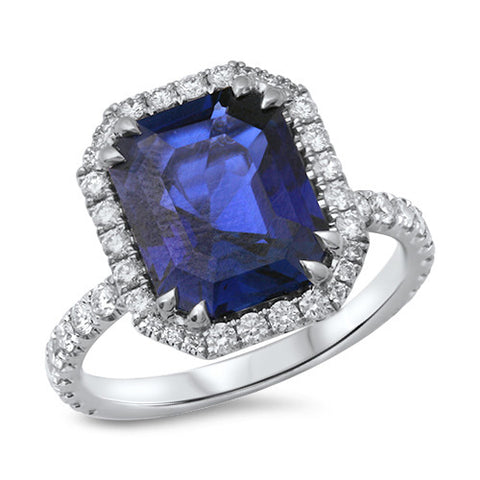A Conversation with Catherine from Gem Hunt
We sat down with Catherine over at Gem Hunt (Instagram) and talked about all things sapphire. Check out the Q & A below:
C: Tell me a little about your company Blue Sapphire Stones and how it go started?
N: We’re a family that loves sapphires in all colors of the rainbow and we want to share that love and passion for these beautiful colored gems with the world.
It all began when my dad was young and began working in the sapphire trade with his uncle. He was mesmerized by these natural beauties from the very beginning. He started out as a wholesale only sapphire dealer. He walked from door to door, building his client base, and is now known as one of the most trustworthy and reputable sapphire dealers in the US. He’s fostered some amazing relationships along the way.
Ever since I could remember, my dad would fly between Colombo, Sri Lanka and Los Angeles, CA. He would bring back so many beautiful treasures. My siblings and I would put stones aside for our own personal collections. Even though they were small lesser quality pieces, we adored them.
Eventually, we grew up, moved away for school and found passion in other fields. Yet, we ended up coming back to the family business. Since my brother and I started “officially” working with my dad, we expanded our business to the retail world where could share our love for these jewels with everyone (not just wholesale dealers).
We think that one of a kind jewelry begins with the perfect sapphire and since we’ve been helping clients create their dream pieces with sapphires and other colored gemstones.
C: What questions should people ask when they buy a sapphire?
N: The beauty and value of a sapphire is dependent on its color, so the most important question to ask is about the color — how even it is, the saturation, and the hue.
People should also ask about size in measurements rather than weight, even though sapphires and most gemstones, including diamonds are priced per carat. You would want to get a stone that looks big but doesn’t weigh a lot, to get the most bang for your buck. But keep in mind that the deeper the measurement, usually the more saturated the color, so you don’t want a completely flat stone because it won’t have the same sparkle and saturation.
Lastly, you should definitely ask about what sort of treatment the sapphire has undergone. Completely untreated sapphires would be more expensive because of their rarity. Heat-treated sapphires are pretty common and it’s a standard treatment in the industry. Heat treatment helps to dissipate inclusions and deepens the color. We wouldn’t recommend buying a sapphire with any other treatments.
C: What sets your product apart?
N: We only deal in the highest quality sapphires. Ones that are completely untreated or heat-treated only. We source our sapphires straight from the mines, which enables us to ensure that the sapphires, which come into our possession, are ethically mined. We have a special connection with each hand picked sapphire, as it becomes a part of our collection. And most of all we value our relationship with our suppliers and our clients above all else. It’s why people have chosen us over others when they begin searching for the sapphire of their dreams.
C: There is a lot of noise with sapphires about ones that are chemically treated — what is that and why should we watch out for it?
N: The technical term is lattice diffusion. It involves heat-treating sapphires with the addition of chemicals, including titanium, iron, and beryllium. Beryllium diffusion has been the most successful in making a lasting change and improvement in color and clarity of a sapphire. Yet, most of us in the industry would not recommend sapphires with this treatment because it isn’t a natural heat treatment process.
We think clients should watch out for it because, we ourselves, are concerned about the long-term health effects for both people that are involved in the process of treating the gems and people that eventually wear them. Beryllium vapor is known to be highly toxic and people who operate the treatment are at risk for detrimental, respiratory health effects.
C: What’s your favorite part of working with sapphires?
N: My favorite part about working with sapphires is their versatility. They come in so many different colors, shapes, sizes, etc. and any sort of piece of jewelry or accessory can be designed with a sapphire in mind. Sapphires are also durable, a 9 on the MoHs scale, which is just one notch below a diamond. Sapphires also have a history and lore surrounding it, which make it an awe-inspiring gem. It represents royalty and romance, truth and sincerity, and even faithfulness.
Personally, it represents a connection to my family’s heritage, a precious natural resource in Sri Lanka, and an interest that my dad and I share.
C: Do you have a favorite ring on the website?
N: It’s hard to pick one absolutely favorite ring, so I have two — a dream/fantasy option and a realistic one.
My fantasy option (yes it comes first) is this absolutely dreamy 5.08ct emerald cut blue sapphire ring, with diamonds covering all angles. I love the deep royal blue of the center stone and the daintiness of the piece overall despite the huge rock at the center.
A more realistic option, one that I could probably treat myself with on my birthday or be ecstatic to have as an engagement ring: is this pretty little padparadscha sapphire at the center of a tapered diamond band in yellow gold. I think the colors go so well together! And it’s just the right size to wear every day without being too flashy (even though there’s nothing wrong with some flash!).
Check out the original interview on Gem Hunt.


